Exploring the Different Categories of Stand-Up Paddleboards

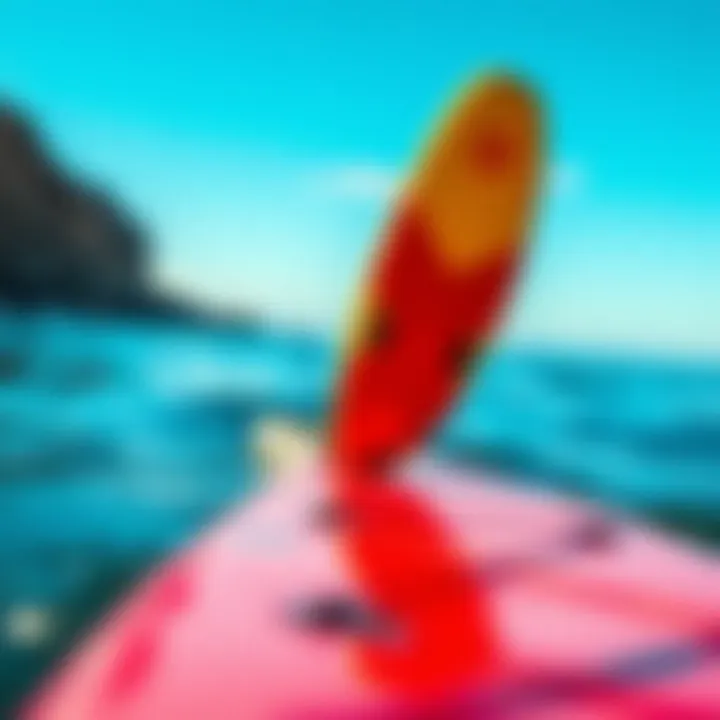
Intro
Stand-up paddleboarding (SUP) has taken the water sports scene by storm, evolving from a niche activity to a mainstream favorite. To the untrained eye, all paddleboards may look similar, but underneath their sleek exteriors lies a world of diversity tailored for different waters, conditions, and adventures. It’s essential for paddlers—whether novices or seasoned water enthusiasts—to understand these distinctions to pick the board that best fits their pursuits.
Different types of paddleboards serve various purposes. From leisurely paddling on calm lakes to carving waves in ocean surf, each board is designed with unique features that enhance performance and experience. Understanding these differences enables paddlers to make informed decisions when selecting equipment, ultimately leading to better adventures on the water.
The World of Stand-Up Paddleboards
The journey into the realm of paddleboards starts with recognizing three major categories: all-around boards, touring boards, and inflatable boards. Each type caters to specific needs, making the choice crucial for enjoyment and safety. By diving into the details of these classifications, this article will help you decipher the appropriate board for your next seaside escape, lake day, or challenging whitewater adventure.
Prelude to Stand-Up Paddleboarding
Stand-up paddleboarding is more than just a trendy water sport; it's a doorway to adventure and a means to connect with nature. The activity has grown immensely in popularity due to its accessibility and versatility, making it suitable for individuals of all ages and skill levels. Whether you’re seeking a calm morning paddle at dawn or an exciting day on choppy waters, stand-up paddleboarding offers a unique way to experience the great outdoors.
The significance of this topic lies in its broad applicability. With a diverse range of paddleboards available, it's crucial for paddlers to understand the characteristics each type brings to the table. Choosing the right board not only enhances the on-water experience but also influences performance and safety. With a better grip on this information, both newcomers and seasoned paddlers can make informed choices that best suit their paddling adventures.
Among the key benefits of stand-up paddleboarding are:
- Enhanced physical fitness: Engaging your core and upper body while maintaining balance can be a fantastic full-body workout.
- Mental clarity: Being on the water often inspires tranquility, allowing for a meditative escape from the daily hustle.
- Versatility: From leisure paddling to more demanding activities like racing, there’s a board type for every interest.
- Environmental connection: Gliding across lakes and oceans cultivates a deeper appreciation for nature, possibly inspiring environmental stewardship.
However, there are many considerations when venturing into this realm. Knowing the types of boards and their specifications will help paddleboarders maximize enjoyment while minimizing risk. Factors like board length, width, and material can significantly affect stability, speed, and maneuverability.
Overall, the introduction to stand-up paddleboarding sets the stage for a deeper exploration into the various types of boards available today. This knowledge equips readers to select the best board tailored to their individual needs and enhances the overall paddleboarding experience. As we delve deeper into each category, you'll uncover unique attributes that can guide your decisions and elevate your time on the water.
Understanding Stand-Up Paddleboards
Stand-up paddleboarding (SUP) has surged in popularity over the years, and for many reasons, it’s vital to understand the various elements that make up a paddleboard. Knowing the fundamentals of stand-up paddleboards not only enhances your ability to choose the right board but also informs how you can maximize your experience on the water.
Importance of Understanding Paddleboards
Grasping the core concept behind paddleboards is crucial for both beginners looking to start their journey and seasoned paddlers aiming to elevate their skills. While some might think a paddleboard is simply a board to stand on, there’s more to it. Each board is designed with specific purposes in mind, whether it's cruising, racing, or engaging in yoga.
- Choosing the Right Board: Understanding the different types can directly influence your enjoyment and performance. Is your goal to catch waves, fish, or simply explore calm lakes? Knowing which board is best suited for your activity can prevent mishaps and enhance the overall experience.
- Performance Insights: Each paddleboard has its design nuances, affecting handling and stability. Knowledge of these aspects can sharpen your paddling technique, leading to improved speed and agility.
- Safety Considerations: Being aware of the specifications can boost your confidence, especially in various water conditions. Understanding weight limits, buoyancy, and construction materials contributes to making educated decisions on safety measures.
"With paddleboarding, it’s not just about gliding across the water; it’s about selecting a vessel that harmonizes with your intent and environment."
Benefits of Understanding Paddleboards
Delving into the specifics can uncover benefits that are often overlooked:
- Customization: Some paddleboards allow for additional gear attachments, such as fishing rod holders or storage containers.
- Efficiency in Movement: Different board shapes, like wider bases for stability versus narrower ones for speed, influence how you move through water.
- Improved Technique: As paddlers understand their equipment, they improve their overall technique, leading to a more enjoyable and less strenuous experience.
Considerations about Paddleboards
When it comes to choosing the right paddleboard, certain considerations stand at the forefront:
- Skill Level: A beginner might fare better on a stable all-around board, while an experienced paddler may prefer a racing board for performance.
- Water Conditions: From reflective lakes to choppy ocean waves, the water environment directly influences which design will thrive.
- Transport and Storage: Given that not all paddleboards are easily transportable, understanding the implications of this on your lifestyle is significant.
By working through these factors thoroughly, enthusiasts can align their objectives with the characteristics of various paddleboards, leading to more fulfilling and safer outings.
In a nutshell, understanding stand-up paddleboards means more than just knowing how to paddle. It encompasses an appreciation of the varying designs, materials, and purposes that these boards serve, embedding a deeper respect for the sport and maximizing one’s time afloat.
All-Around Paddleboards
All-around paddleboards represent the jack-of-all-trades in the world of stand-up paddleboarding. These boards strike a balance between stability and versatility, making them an excellent choice for those who are just stepping into the sport or for seasoned paddlers looking for a reliable board that can perform in various environments. The importance of the all-around paddleboards lies in their design, accommodating every range of paddler from beginners to experienced users. Here, we break down the essential design features that make them stand out and explore their varied use cases.
Design Features
All-around paddleboards typically range from 10 to 12 feet in length, boasting a width of 30 inches or more. This width provides better stability, which is crucial for novice paddlers learning to maintain balance. The shape is generally wider and flatter compared to racing or surf boards, allowing for a stable ride even in choppy waters.
Some key design elements include:
- Flat Nose: Helps in cutting through water efficiently, reducing drag.
- Rounded Tail: Offers better maneuverability, making it easy to turn.
- Moderate Rocker: Ensures easy gliding while enabling users to catch small waves.
- Material Composition: Most all-around boards are made of durable materials such as high-density foam and are often either hard or inflatable. Inflatable models are especially popular due to their portability.
These boards often feature attachment points for gear, allowing paddlers to bring essentials. Increased storage capacity is a defining feature that sets all-around boards apart from more specialized types. Overall, the design amalgamates performance and comfort, ensuring that users can paddle longer without feeling fatigued.
Use Cases
The versatility of all-around paddleboards means they can be used in various scenarios, making them suitable for different types of water activities. Here are some prominent use cases:
- Leisurely Paddling: Ideal for peaceful lake rides or calm coastal waters, these boards provide a secure platform for enjoying the outdoors. Many people use them to simply glide on serene water, taking in the scenery, and enjoying a bit of exercise.
- Yoga Practice: Due to their stability, these boards serve well for yoga enthusiasts who want to blend their practice with nature. The flat deck allows space for different poses while ensuring a stable base.
- Light Tour Adventures: For those who may not want to invest in a touring-specific board, all-around boards can still manage bit of distance paddling. They handle longer trips due to their balanced design, accommodating some gear and supplies.
- Family Fun: If you have children or pets, an all-around paddleboard is a great choice for group outings. Their stable nature makes it easier for multiple passengers to share the board comfortably.
Understanding all-around paddleboards helps paddlers of all levels discover which features fit their paddling style. With a combination of stability, usability, and storage, these boards cater to a wide range of paddling experiences, making them indispensable for anyone looking to venture into stand-up paddleboarding.
"All-around paddleboards are like the Swiss Army knives of the water; a reliable companion for every adventure."
Discover more about paddleboarding at Wikipedia - Paddleboarding.
Explore community discussions on boards on Reddit.
Visual guides and product recommendations can be found on various surfing forums and community groups on platforms like Facebook.
For tips and tricks on maintaining your paddleboard visit Britannica.
Touring Paddleboards
Touring paddleboards are designed for those who seek the thrill of long distances on the water while enjoying the serenity of nature. These boards present a unique blend of functionality, comfort, and performance that is critical in making them a favored choice for adventurers and leisure seekers alike. The significance of touring paddleboards lies in their specialized features that make extended trips on various water bodies not only feasible but also enjoyable. By focusing on their unique elements and practical benefits, this section will guide enthusiasts towards understanding what makes touring paddleboards stand out.
Key Attributes
When it comes to touring paddleboards, certain key attributes set them apart from other types. Here are some of the defining features that one should look for:
- Length and Width: Typically longer than other types, touring boards range from 12 to 14 feet. Their increased length aids in maintaining a straight path, while a narrower width enhances speed.
- Shape and Design: Touring boards often showcase a pointed nose or bow that slices through water smoothly. This streamlined design reduces resistance, enabling paddlers to cover long distances efficiently.
- Deck Rigging: An essential element in touring boards is the deck rigging. This feature allows paddlers to secure gear, such as dry bags or camping equipment, making them versatile for multi-day trips.
- Construction Materials: Most touring boards are made from lightweight materials like fiberglass or composite materials to balance sturdiness with portability. These materials offer resilience against potential bumps and scrapes from rocks or docks.
- Stability Features: Despite their narrow design, touring boards have certain stability enhancements, like a wider tail or flatter bottom, to ensure they remain steady on a variety of waters.
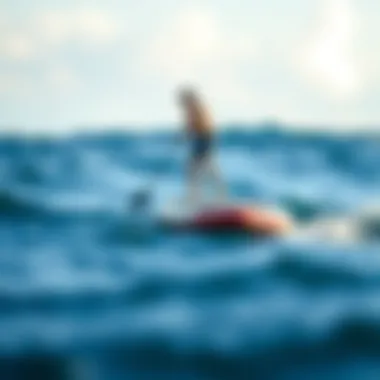
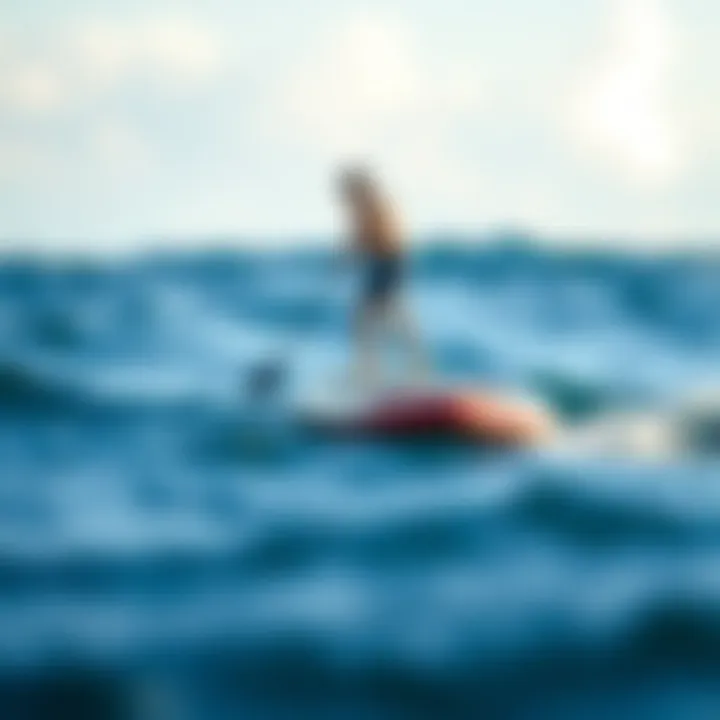
Touring paddleboards incorporate these key attributes to ensure that paddlers not only maximize their speed but also maintain a comfortable riding experience over extended periods.
Ideal Environments
The environment in which one chooses to paddle can significantly impact the overall experience. Ideal settings for touring paddleboards generally include:
- Lakes and Open Water: Calm lakes provide an excellent backdrop for touring, allowing paddlers to enjoy long voyages without the interruptions of waves.
- Coastal Areas: Paddling along the shoreline or in coastal bays can offer beautiful sights and ease of access to land for breaks.
- Rivers and Estuaries: These bodies often present opportunities for exploration, with varying scenery to keep the journey engaging. However, caution is advised for fast currents or narrow waterways.
- Protected Waters: Areas safe from strong winds and sizeable waves provide excellent conditions for leisurely paddling, ensuring that paddlers remain focused on their route and surroundings.
Touring paddleboards shine in environments where distance can be both covered and enjoyed. Their design complements the demands of such diverse water conditions.
Understanding these environments helps paddlers plan their trips better, identifying pathways that align with their capabilities and the inherent features of their touring boards.
Inflatable Paddleboards
Inflatable paddleboards have carved out a significant niche in the world of stand-up paddleboarding, appealing to paddlers of all kinds. One of the main draws of inflatable boards is their versatility combined with an ease of use that can't be overlooked. They provide a practical solution for those who may not have the space for hardboards or who are looking for a more portable option. This section will explore the advantages and disadvantages of inflatable paddleboards along with their storage and transport benefits.
Advantages and Disadvantages
When considering inflatable paddleboards, there are various aspects to weigh. Here’s a look at the benefits:
- Portability: Inflatable boards deflate to make them surprisingly compact. This is perfect for eager adventurers who enjoy traveling without being bogged down by heavy gear.
- Durability: Constructed from sturdy materials like PVC, many inflatable boards are resistant to dings and scratches, ideal for rocky or shallow waters.
- Stability: Their wider build often promotes stability, making them a good choice for beginners or those engaging in activities like yoga on the water.
However, some disadvantages include:
- Performance: They may not glide as smoothly or respond as quickly as some hardboards, which can affect speed and performance in competitive settings.
- Inflation Time: Setting up an inflatable board does require a bit of time with a pump, unlike hardboards that can be ready to go immediately.
"Inflatable paddleboards stand out for their flexibility and ease, but aspiring paddlers must evaluate their specific needs to determine if they align with this board type."
Storage and Transport Benefits
The storage and transport benefits of inflatable paddleboards can’t be emphasized enough. Given today’s busy lifestyles, efficient storage solutions are critical for enthusiasts. Here are some key points:
- Space Efficiency: Inflatable boards can be rolled up into a compact package, often fitting into a backpack or carrying case. This makes for easy storage in apartments or smaller spaces.
- Convenience for Travel: Whether packing your board for a trip or on a family camping excursion, the lightweight and compact nature of inflatable boards means no bulky roof racks required. It's as simple as stowing it in your trunk and hitting the road.
- Accessibility: Many inflatable boards come with pumps and repair kits included, making them instant-ready for any adventure at a moment’s notice.
The practicality of inflatable paddleboards makes them a significant category within the overall paddleboarding scene. With their unique advantages, they cater to a diverse crowd—from casual paddlers to travelers looking for adventure. Understanding both their potential and their limitations aids paddlers in selecting the best type of board for their journeys, ensuring their paddling experiences are as enjoyable as possible.
Surf Paddleboards
Surf paddleboards, often considered the adrenaline-pumping cousin of traditional stand-up paddleboarding, hold a unique place in the paddler's toolkit. Their specific design caters to athletes eager for dynamic water experiences, combining the essence of surfing with paddleboarding. Unlike generic boards, surf paddleboards are tailored for performance in the surf zone, a crucial aspect that makes them indispensable for those passionate about both surfing and stand-up paddling.
Specialized Design Considerations
When it comes to specialized design, surf paddleboards differ significantly from other types of boards. These boards are shorter and more maneuverable, traditionally ranging from 8 to 11 feet. This shorter length allows for easier turns and quick responses to wave motions. The lightweight material makes them easier to handle in critical surf conditions.
- Nose Shape: The pointed noses help cut through small waves and navigate choppy water, enhancing the board's slicing ability.
- Tail Design: A squash tail or a rounded tail can improve both speed and the ability to pivot swiftly, vital for executing surf maneuvers.
- Fin Configuration: Typically, surf paddleboards may have a thruster setup, meaning three fins, which offer better stability and turning capability, crucial when dodging larger surf.
"Choosing the right surf paddleboard can be the difference between catching every wave and being left out in the cold."
These design elements all contribute to the overall performance and functionality of surf paddleboards, ensuring that enthusiasts can enjoy the thrill of catching waves with agility and precision.
Optimal Wave Conditions
For those looking to excel in surf paddleboarding, recognizing optimal wave conditions is key to both enjoyment and safety. Each spot can change dramatically with tide flow and wind, so understanding the nuances is part of the game.
- Small to Moderate Waves: These conditions are ideal for beginners looking to hone their skills. It allows for practice without the overwhelming fear of getting knocked off balance by larger swells.
- Steep Waves: Advanced paddlers thrive on steep waves, demanding precision and excellent technique. This is where skills are tested to their limits, with riders using their boards to carve down the face of the wave.
- Wind Factors: Offshore winds can create clean, peaky surf, while onshore winds can make for more challenging conditions, producing disorganized chop. Being aware of these factors can significantly enhance a surfer’s experience.
Choosing the right day and conditions can transform an ordinary outing into a thrilling adventure.
As we dive deeper into the world of paddleboarding, it becomes clear that knowing the specificities of surf paddleboards opens the door to an exciting blend of sport and skill. Understanding their design and recognizing the best conditions may just be the key to elevating one’s experience to new heights.
Racing Paddleboards
Racing paddleboards hold a significant place in the paddleboarding landscape. For enthusiasts looking to compete or simply increase their speed on the water, these boards serve as the tools of choice. Their specific designs and characteristics cater to performance, making them ideal for racing conditions. Choosing the right racing paddleboard can mean the difference between breaking personal records or falling short during competition. With this in mind, it's essential to understand what makes these boards stand out from their more leisurely counterparts.
Performance Specifications
The performance of racing paddleboards mainly depends on their length, width, and shape. Generally, these boards tend to be longer and narrower than standard models, often measuring between 12'6" to 14' in length. The length provides better glide, which is crucial for long-distance racing. The narrow width reduces drag and allows paddlers to slice through the water more effectively.
Key performance specifications include:
- Weight: Racing boards are usually lighter, allowing for better maneuverability and speed.
- Rocker: Minimal rocker helps maintain speed on flat water surfaces.
- Stability: This varies significantly among boards. A balance between stability and speed is essential, especially for longer races/long distances.
In essence, when selecting a racing paddleboard, it’s vital to consider these specifications. They define how the board responds in the water, impact overall performance, and contribute to the paddler's experience.
Competitions and Events
Participating in paddleboarding races can be an exhilarating experience. Events cater to various skill levels, from local events to well-established competitions like the Stand Up Paddleboard Association events. These races not only promote physical fitness but also foster a community spirit among paddleboarders.
Key points about competitions and events include:
- Types of Races:
- Age Categories: Many competitions feature categories based on age and skill levels, allowing everyone to participate.
- Event Location: Ideal racing conditions often come with flat waters, making lakes and coastal areas prime venues for these events.
- Sprint Races: Short-distance events usually around 200 meters, focusing on speed.
- Distance Races: Challenge endurance over longer stretches, often from several miles to over 10-miles.
"Racing not only enthuses the paddler’s competitive spirit but also creates a network of like-minded individuals sharing strategies and passions."
As racing paddleboards continue to evolve, so do the competitions surrounding them. Keeping up-to-date with local and international events can inspire both new and experienced paddlers to engage in races and improve their skills.
Fishing Paddleboards
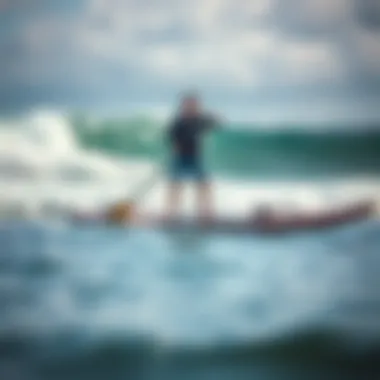
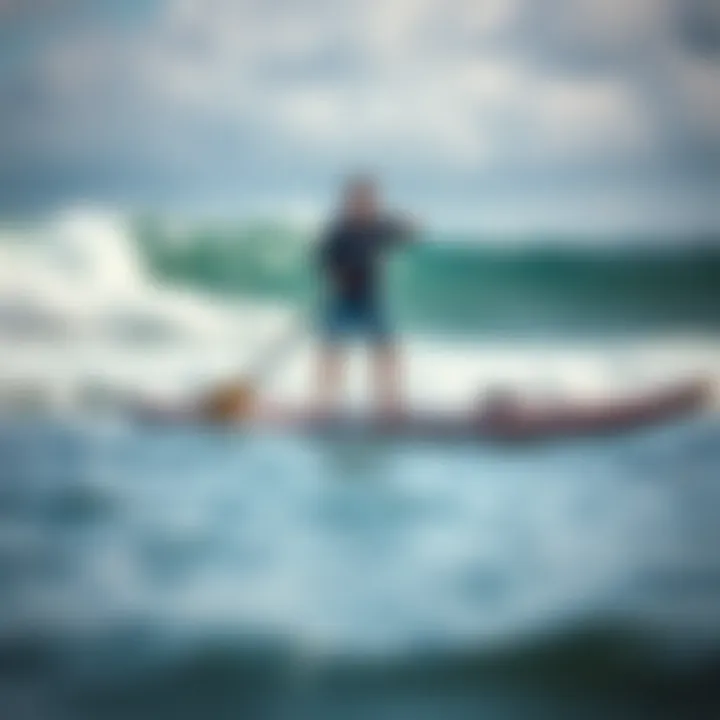
Fishing paddleboards have carved out a distinct niche among various types of stand-up paddleboards. While the primary function of most SUPs is recreation and leisure, fishing paddleboards cater specifically to enthusiasts aiming to mingle angling with adventure. These specialized boards are designed to enhance stability, provide ample storage for gear, and support a smooth, enjoyable fishing experience on the water. Having the right board can make all the difference in ensuring a successful day on the water, particularly for those preferring quieter, shallower waters.
Features for Fishing Enthusiasts
When searching for a fishing paddleboard, several features should catch the eye of any serious angler. Here are some key elements that differentiate fishing boards from standard SUPs:
- Stability: Fishing paddleboards are generally wider than other models, providing a more stable platform for casting and reeling without the risk of tipping over.
- Storage Options: They come equipped with bungee cords, built-in coolers, and tackle storage compartments, allowing for convenient access to gear and keeping essentials nearby.
- Mounting Points: Many boards include integrated mounts for fishing rods, transducers, and even fish finders, making it easier to gear up for a successful day of fishing.
- Material Composition: Fishing paddleboards often utilize durable materials that withstand water elements and rough handling, ensuring longevity.
- Comfort Features: Most boards will have cushioned seats or adjustable footrests, allowing for longer periods spent out on the water without discomfort.
These features collectively foster an environment where fishing can be enjoyed without the distractions often found in more traditional means. With the right installation, you can ensure that every fishing trip is productive.
Best Fishing Locations
Identifying the right body of water can greatly impact your fishing adventure. Here are some of the top fishing locations that pair well with paddleboard fishing:
- Lakes: Tranquil lakes often provide a multitude of fish species, from bass to trout. Their calm surfaces also allow for easy paddling and maneuverability.
- Estuaries: These regions, where freshwater meets saltwater, are teeming with marine life. Exploring these areas by paddleboard can lead to some fantastic catches.
- Coastal Areas: When conditions are right, fishing along the coast can yield impressive results. Take care to be mindful of tides and local regulations.
- Shallow Rivers: Many freshwater species thrive in shallow rivers, making them ideal for paddleboard fishing. A low profile allows for easy casting and spotting of fish beneath the surface.
Ultimately, fishing from a paddleboard opens doors to unique locations that may be inaccessible by boat or land. By selecting the right board and understanding the key features to look for, you can make the most of your paddleboarding experience while enjoying your favorite pastime.
"Fishing paddleboards mix tranquility with adventure, enhancing both the sport of fishing and the art of paddling."
For more information on the latest fishing gear and paddleboards, you can check out resources like Wikipedia or join local discussions on Reddit.
Yoga Paddleboards
Yoga paddleboards have emerged as a significant segment in the world of stand-up paddleboarding. The practice integrates the serene elements of yoga with the calming effects of water, creating an enchanting experience for practitioners. When paddleboarders transition from solid ground to the gentle sway of the water, they engage in a holistic approach that promotes physical health and mental tranquility. Not only is this an excellent way to improve balance and strength, but it also offers a unique venue for meditation.
Design for Stability
One of the paramount features of yoga paddleboards is their design for stability. In order to facilitate complex poses and transitions, these boards tend to be wider and longer than standard paddleboards. This increased surface area not only enhances stability but also makes it effortless for users to maintain their balance while practicing yoga. A typical yoga paddleboard may be around 32 inches wide, allowing for ample space to stretch, bend, and flow through various poses without the fear of tipping over.
The material used for these boards also plays a vital role in their design. Most are made from high-quality, durable materials that withstand wear and tear but also provide just enough give to absorb the water’s movement. Many models come with features like a textured surface, allowing practitioners to maintain grip even in wet conditions.
"A stable platform on water leads to a mind cleared of distractions, making every session purposeful and focused."
Incorporating Yoga into Paddling
Integrating yoga into paddleboarding brings about numerous benefits. First and foremost, it cultivates an enhanced awareness of one’s body in relation to the environment. As the board gently rocks on the water, the paddler learns to engage core muscles and strengthen their focus. Many enthusiasts find that performing poses such as downward-facing dog or boat pose while on the water promotes deeper awareness of their breath and body alignment.
Moreover, this combination can also serve as a perfect opportunity for personal reflection and mindfulness. Each glide across the water can evoke a sense of peace, fostering emotional well-being as one connects with nature. Practicing yoga while paddling often encourages participants to embrace the flow of both water and breath—making each movement a practice of letting go and being present.
In terms of structure, a session of yoga paddleboarding might look something like this:
- Warm-Up: Gentle stretches to pilot into the practice.
- Paddling: A slow paddle to the chosen spot for practice, integrating breathing techniques.
- Yoga Practice: A series of poses focusing on balance, flexibility, and core stability.
- Cool Down: A few minutes of floating or meditating, soaking in the beauty around.
Ultimately, yoga paddleboards are more than just tools; they embody a lifestyle that captures the essence of being in harmony with the waters and oneself. Whether you are a seasoned yogi or a novice paddler, the combination of yoga and paddleboarding can create a transformative experience. For those looking to elevate both their fitness and mindfulness practices, investing in a good yoga paddleboard might be an ideal step forward.
Choosing the Right Paddleboard
Selecting the right paddleboard can set the stage for your entire experience on the water, whether you’re a beginner dipping your toes in or a seasoned paddler looking for a specific performance edge. It’s not just about hopping onto any board that floats; it’s about making informed decisions to enhance your enjoyment and safety as you glide across lakes, rivers, or waves. Understanding the different types of paddleboards available and matching them with your activity goals maximizes your performance and comfort.
When you choose the right paddleboard, you ensure that your outings are not just enjoyable but also efficient and safe. The board's size, shape, and design affect how it handles in the water, which can make a world of difference. Before you rush off to make a purchase, a few key factors are essential to consider, including your paddling style, skill level, and the environment where you’ll be paddling.
"Choosing the right equipment can be the make-or-break element in any sport; paddleboarding is no different."
Factors to Consider
When navigating the choice of paddleboards, the first step is to assess what you’ll be doing most often.
- Board Size: The length and width influence stability and maneuverability. For example, shorter boards tend to be better for surfing while longer ones provide speed and tracking for touring.
- Board Type: As outlined in earlier sections, boards serve different purposes, whether you’re fishing, racing, or doing yoga.
- Weight Capacity: It’s crucial to check the weight limits for different boards to avoid compromising your performance.
- Construction Material: Hardboards offer speed and performance, whereas inflatable options are great for portability but may not be as fast or stable.
- Fin Configuration: The number and design of fins impact tracking and stability; different setups suit different paddling conditions.
Taking into account these elements before making your selection turns a potentially overwhelming decision into a straightforward one.
Personal Preferences
Each paddler has unique tastes and requirements that are shaped by personal experiences and ambitions.
- Aesthetic Appeal: Some might lean towards vibrant colors and artistic designs while others prioritize functionality over looks.
- Comfort: Individuals will have differing preferences for grip or paddling posture, often based on prior experiences in different activities.
- Intended Use: Whether leisurely paddling, racing, or fishing plays a significant role in what one might prioritize when selecting a board.
- Budget Constraints: Paddleboards can vary significantly in price. Determine your budget beforehand to avoid any sticker shock later.
Finding the right balance between personal preferences and practical factors can lead to a positive experience on the water. Always remember that it’s not just about the paddleboard; it’s about what you want out of your paddling experience. Researching, trying out different boards, and engaging with fellow paddlers can ease your decision-making process.
Maintenance of Paddleboards
Maintaining your paddleboard is more than just a routine task; it’s a foundational aspect that significantly impacts its longevity and performance. Proper care of your paddleboard not only ensures that it remains in prime condition, but it also enhances your overall experience on the water. Engaging in regular maintenance can save paddlers from costly repairs and help retain the board’s performance attributes. Here’s a closer look at why maintenance is essential and how you can keep your paddleboard in the best shape possible.
Cleaning Practices
Cleaning your paddleboard is crucial for several reasons. First, it prevents the build-up of algae, grime, and salt that can degrade materials over time. If left unchecked, these contaminants can lead to a less enjoyable paddling experience, especially when conditions get slippery.
Here are some steps to effectively clean your paddleboard:
- Freshwater rinse: After each use, especially in saltwater, rinse the board thoroughly to remove any salt and sand.
- Use mild soap: If there are stubborn stains or marks, a gentle soap combined with a soft scrub brush can do the trick without damaging the board's surface.
- Drying: After washing, let the board dry completely in a shaded area to prevent UV damage.
- Inspect for damage: While cleaning, take the time to check for dings or scratches. Addressing these promptly can prevent more significant problems later on.
Storage Best Practices
Proper storage of your paddleboard can prolong its life and ensure it's ready to ride whenever you are. Poor storage can lead to warping, fading, and even mold growth, particularly for inflatable boards.
Here are some storage tips to keep in mind:
- Keep it out of the sun: Extended exposure to direct sunlight can degrade the material of your paddleboard. Store it in a cool, shaded area or indoors.
- Flat positioning: If possible, store the board flat to avoid warping. If hanging, ensure that it’s done in a way that evenly distributes weight along its length.
- Inflatable boards: Make sure the board is fully deflated and dry before storing it. This prevents any moisture from getting trapped inside, which can cause mold.
- Cover it up: Using a breathable storage bag can shield the board from dust and enable airflow, thus reducing the risk of mildew.


"A well-maintained board is a happy board. Take the time to care for your gear and it will reward you with countless adventures on the water."
In understanding paddleboard maintenance, it’s clear that investing a little time and effort can lead to a vastly improved paddleboarding experience. Keeping your board clean and stored correctly is key to ensuring it serves you well on many outings ahead. Regular checks and cleanings will make paddling more enjoyable and could become part of your routine.
Trends in Paddleboarding
The realm of stand-up paddleboarding continues to evolve, showcasing exciting trends that resonate with both enthusiasts and newcomers alike. As paddleboarding gains traction globally, awareness of the latest designs and sustainable practices becomes increasingly relevant. This section dives into the emerging designs and innovations that make waves and the growing focus on sustainability. Let’s peel back the layers and understand why these trends matter.
Emerging Designs and Innovations
In recent years, paddleboard manufacturers have introduced a plethora of designs that cater to various needs and preferences. New technologies have taken center stage, resulting in boards that exhibit improved performance and versatility. Some notable trends emerging in paddleboard design include:
- Hybrid Shapes: Combining different styles has led to boards that excel in multiple environments, allowing paddlers to transition seamlessly from lakes to coastal waters.
- Advanced Materials: Use of lighter, stronger materials such as carbon fiber and advanced epoxy resins improves durability while reducing weight, enhancing ease of transport.
- Customizable Features: Many boards now offer customizable options, like removable fins and adjustable foot straps, enabling users to tailor their paddleboarding experience.
- Smart Technology Integration: The use of built-in GPS, performance tracking, and even waterproof speakers are becoming more common, enriching the experience and providing data to paddlers.
These innovations are pivotal not just for casual paddlers who seek enjoyment but also for competitors aiming to shave seconds off their race times. They represent a shift towards enhancing functionality without compromising on performance.
Sustainability in Paddleboarding
With a growing awareness of environmental issues, the paddleboarding community is also leaning towards more sustainable practices. This reflects a broader trend in outdoor sports to prioritize eco-friendliness. Here are some key considerations regarding sustainability in paddleboarding:
- Eco-Friendly Materials: Manufacturers are increasingly adopting eco-conscious materials. Boards made from recycled plastics or sustainable wood sources are hitting the market, reducing waste and pollution.
- Responsible Manufacturing: Brands that prioritize ethical production methods contribute positively to the environment. Practices like minimizing water usage and energy-efficient manufacturing are becoming the norm.
- Impact Awareness: Paddling enthusiasts are becoming more mindful about respecting natural habitats. Initiatives that promote leave-no-trace principles are gaining momentum, encouraging paddlers to protect the ecosystems they enjoy.
- Community Initiatives: Many paddleboarding communities organize clean-up events or collaborate with conservation organizations. This fosters a sense of responsibility and community among paddlers.
"As paddleboarding grows in popularity, the responsibility to protect our waterways becomes clearer. By choosing sustainable options, we ensure that future generations can enjoy the beauty of the great outdoors."
The focus on sustainability is not merely a trend but a necessity in the paddleboarding community. It enhances the overall paddleboarding experience and ensures that nature remains an everlasting backdrop to this exhilarating sport.
These trends are reshaping how we think about paddleboarding, from innovative complexities to eco-conscious practices. Recognizing and engaging with these trends isn’t just beneficial; it’s essential for anyone involved in the paddleboard community.
Closure on Types of Paddleboards
In the ever-expanding world of water sports, stand-up paddleboarding stands out as an intriguing and flexible activity that tailors itself to a variety of enthusiasts. Each paddleboard type—whether it’s an all-around, touring, inflatable, or specialized board—has its distinct strengths and is designed for specific conditions and purposes. Understanding these differences is crucial for anyone looking to make an informed choice about which board aligns best with their aspirations.
When discussing types of paddleboards, several factors come into play. First and foremost, users need to consider their primary use case. For instance, someone aiming to explore lakes may find the stability and portability of an inflatable board appealing, while a surfer would likely gravitate towards a surf paddleboard designed to catch waves.
Also, the importance of stability versus speed cannot be understated. Paddleboards engineered for racing typically favor streamlined designs that can handle rapid movements, while those built for yoga focus on broader, sturdier bases to ensure a safe practice session on the water. Such distinctions carry significant weight for potential users when choosing a board and affect their overall experience.
Furthermore, materials and construction types are critical considerations. The blend of durability and weight can greatly influence performance. Inflatable boards are excellent for transport but may not match the rigidity of a solid board. Those seeking longevity and high performance must weigh these material choices seriously.
Key points highlighted throughout this article include the versatility of all-around boards, which cater to beginners and adaptable enthusiasts, and the specialized features found in touring and racing boards that cater to more advanced athletes. By comprehensively examining these different types, it's clear that paddleboard buyers can make decisions rooted in keen awareness rather than impulse.
Ultimately, as paddleboarding continues to gain traction, understanding the varied types of paddleboards is not just beneficial but essential. It allows individuals to engage with the sport in ways that meet their personal goals, whether that be fitness, adventure, or leisure. A well-chosen paddleboard can make all the difference in one’s enjoyment and proficiency in the sport.
As the paddleboarding landscape evolves with new trends and technology, staying informed will ensure enthusiasts maximize their time on the water. This knowledge empowers users to not just pick any board off the rack, but to select a vessel that truly resonates with their paddling journey.
"Knowledge is the key to mastering your paddleboarding experience. Equip yourself wisely to enjoy the ride!"
For further reading and insights, visit Wikipedia's Stand-Up Paddleboarding or engage with fellow paddleboarders on Reddit. Additionally, consider connecting with local clubs through Facebook to enhance your paddleboarding adventure.
Future Directions for Paddleboarding
The landscape of paddleboarding is shifting, shaped by innovation and community engagement. Understanding future directions helps paddlers anticipate changes, including advancements in technology and the growth of local communities. Such insights can make a world of difference, as they prepare enthusiasts for what’s coming around the bend.
Technological Advancements
The role of technology in paddleboarding is becoming increasingly prominent. Boards are evolving from basic designs to high-tech tools. One notable trend is the integration of smart features, such as GPS trackers and fitness monitors. These gadgets help riders track their paddling distances, speed, and even calories burned, making it far easier to set and achieve personal goals.
Moreover, advancements in materials are restructuring the construction of paddleboards. Manufacturers are experimenting with lightweight carbon fiber and advanced polymers, making boards more durable yet easier to carry. The push for sustainability is also on the rise; companies are developing eco-friendly boards that minimize environmental impacts.
Other innovations include:
- Self-inflating technology: Some boards come with a self-inflating mechanism, negating the need for manual pumps, thus enhancing convenience for users.
- Modular designs: Future models may allow paddlers to mix and match components according to personal preference, whether it’s adapting a board for fishing, racing, or leisurely gliding.
- Augmented Reality (AR) applications: Imagine using AR glasses to display real-time data about your surroundings or water conditions while paddling. This tech may not be far off.
"In the coming years, the paddleboarding experience will not only be about the board itself but also how well it integrates with users' daily lives."
Growing Communities
As paddleboarding gains traction, the sense of community around the sport is flourishing. Social media platforms such as Facebook and Reddit are buzzing with groups where enthusiasts share tips, organize meet-ups, and discuss their experiences. Local chapters are popping up all over the place, serving as a hub for paddlers to connect. This community aspect becomes a rich resource for newcomers and seasoned pros alike, fostering a culture of support and collaboration.
Participation in organized events, like race competitions or charity paddles, is on the rise too. These gatherings not only promote the sport but also contribute to a vibrant network of paddlers who inspire each other. You might find specialized clubs focusing on unique interests, such as eco-conscious paddling or adventure tourism.
Benefits of Community Engagement:
- Knowledge Sharing: Veterans impart their wisdom to novices, creating a robust learning environment.
- Networking Opportunities: Connections made at events can lead to partnerships, whether for competitions or business ventures.
- Environmental Advocacy: Many paddlers are becoming more conscious of their impact on waterways, advocating for clean oceans and responsible paddling practices.
As these communities grow and evolve, they not only enhance the paddling experience but also lay the groundwork for future generations of paddleboarders.
Resources for Paddleboarding Enthusiasts
Having the right resources at hand can transform the experience of stand-up paddleboarding from a basic activity to an enriching adventure. Paddleboarding isn’t just about gliding across the water; it’s about immersing oneself in the lifestyle, gathering knowledge, and building connections. Resources offer not only practical information but also inspiration, enhancing skills and understanding of the sport. Whether you’re a novice seeking guidance or a seasoned paddler looking to expand your horizons, the right resources can streamline your journey and elevate your experience.
Recommended Reading and Websites
Reading materials and online platforms provide insights that can boost your paddleboarding journey in various ways:
- Books: Consider titles that delve into paddleboarding techniques, safety measures, or even the history of the sport. For instance, "The Stand Up Paddleboard Book" by Rob Casey offers practical tips along with stunning visuals.
- Websites: There’s a treasure trove of information online, from dedicated SUP sites like SUPConnect.com to forums like Reddit’s paddleboarding sections, where enthusiasts share personal experiences and knowledge.
Additionally, check out resources such as:
- Wikipedia's Paddleboarding
- Britannica- Paddleboarding
- Online retailers like REI.com often feature blogs with reviews on the latest boards and gear that can aid in equipment choices.
- Instructional videos on platforms like YouTube that can assist with skill development.
These resources not only inform but also engage, allowing paddlers to explore new techniques and products.
Connecting with Local Communities
Engaging with local paddleboarding communities is a catalyst for personal growth in this sport. It opens doors to shared experiences, camaraderie, and opportunities to learn from seasoned paddlers. It’s not just about making new friends; it’s about gathering tips and tricks that are rich in local flavor.
- Local Clubs: Joining a local paddleboarding club can be an excellent way to find people who share your passion. These communities often organize events, races, and group paddles.
- Meetup.com: This platform can help you find groups near you, connecting to those organizing outings or inviting individuals to join in on adventures.
- Social Media: Platforms like Facebook boast groups dedicated to paddleboarding. Engaging in these networks, whether sharing advice or boasting about your most recent adventures, can enhance the sense of community.
- Events: Community events and races can provide exciting ways to connect, allowing paddlers to test skills against others while enjoying a friendly competitive atmosphere.















